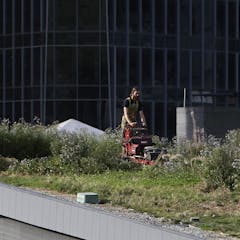
Articles on Urban community
Displaying 41 - 60 of 60 articles

All but a handful of the former public housing tenants are gone. But despite the government again rejecting the recommended heritage listing of the Sirius building, the fight to save it isn’t over.

As adults we often trivialise the value of play. But playing games lets us play with possibilities, see how they play out – and exploring alternative realities helps us see the familiar in new ways.

For the first time in Australia, more higher-density housing than detached housing was being built last year. Compact cities have pros and cons, but the downsides fall more heavily on the poor.

A study of Australian and US cities has demonstrated that pet ownership strengthens people’s connections with their neighbours.

The ubiquitous cafes across Australian cities attract locals and tourists alike, but surely there’s more to thriving neighbourhoods than a flat white.

At society’s margins, people without access to the mainstream job economy are able to carve out lives rich in other resources and community.

Sound, as a still relatively unexplored medium of urban design, provides an obvious starting point in the search for new relationships and identities in the contemporary city.

Communities have an increasing desire to be informed and included in local art, design and infrastructure projects. This has inspired new ways of dealing with noise-afflicted areas.

Must the aggressive, homogeneous global pattern of development take its course in Melbourne’s long-standing multicultural suburb of Footscray?

Over the past 15 years, community groups in a rundown inner-city district have created public murals as part of a successful process of reversing decades of stagnation.

In a nation where urban living is the ultimate attainment, some households are bracing against the surging tide of development.

Religious organisations and community initiatives succeed where disoriented liberal politicians fail.

Modern life is stressful – here’s how to make your local neighbourhood a haven.

Looking back on the legacy of London 2012, it’s clear the local artistic community has lost out.

This playful form of rebellion is empowering people all over the world to move freely around their cities.

In an age of data-driven urban science, we need to remember how Jane Jacobs gave voice to the multiple languages, meanings, experiences and knowledge systems of a vibrant city.

Essential reading for green-fingered urbanites and guerrilla gardeners.

Curbing negative gearing will help get empty housing onto the market. This could go some way to bringing life back to relatively dense urban centres that are oddly lacking intensity of public life.

Australia's transport infrastructure needs urgent upgrades. But with governments willing to fund only one or two major projects, how do we decide which infrastructure project to prioritise?

Black male kids who start out by excelling in STEM gradually lose interest due to low teacher expectations and racial stereotyping. The result? Blacks hold only 6% of all STEM jobs.
